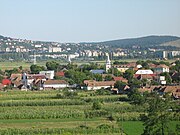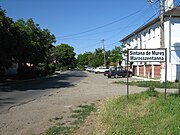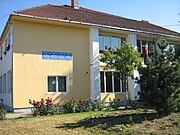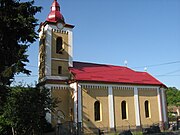| Sântana de Mureș Marosszentanna | |
|---|---|
| Commune | |
 Reformed (Presbyterian) Church Reformed (Presbyterian) Church | |
 Coat of arms Coat of arms | |
 Location in Mureș County Location in Mureș County | |
 | |
| Coordinates: 46°34′N 24°33′E / 46.57°N 24.55°E / 46.57; 24.55 | |
| Country | Romania |
| County | Mureș |
| Government | |
| • Mayor (2020–2024) | Dumitru Moldovan (Ind.) |
| Area | 25.98 km (10.03 sq mi) |
| Elevation | 319 m (1,047 ft) |
| Population | 6,612 |
| • Density | 250/km (660/sq mi) |
| Time zone | EET/EEST (UTC+2/+3) |
| Postal code | 547565 |
| Area code | (+40) 0265 |
| Vehicle reg. | MS |
| Website | www |
Sântana de Mureș (Hungarian: Marosszentanna, Hungarian pronunciation: ; German: Sankt Anna an der Mieresch) is a commune in Mureș County, Transylvania, Romania, composed of four villages: Bărdești (Marosbárdos), Chinari (Várhegy; Schlossberg), Curteni (Udvarfalva), and Sântana de Mureș.
The commune is situated in the central part of the Transylvanian Plateau, at an altitude of 319 m (1,047 ft), on the banks of the Mureș River and its right tributary, the river Voiniceni. It is located just north of the county seat, Târgu Mureș, and belongs to the surrounding metropolitan area.
History
Ancient times
Main article: Sântana de Mureș-Chernyakhov culture See also: Ancient history of Romania, Dacia, and DaciansThe Sântana de Mureș-Chernyakhov culture which flourished between the 2nd and 5th centuries AD in Eastern Europe was named after the sites discovered at Sântana de Mureș and at Cherniakhiv in Ukraine. The culture was spread across what today constitutes Ukraine, Romania, Moldova, and parts of Belarus. It probably corresponds to the Gothic kingdom of Oium as described by Jordanes in his work Getica, but it is nonetheless the result of a poly-ethnic cultural mélange of the Gothic, Getae-Dacian, Sarmatian and Slavic populations of the area.
Modern times
See also: Modern history of RomaniaSântana de Mureș was part of the Székely Land region of Transylvania. Until 1918, the village belonged to the Maros-Torda County of the Kingdom of Hungary. In the immediate aftermath of World War I, following the declaration of the Union of Transylvania with Romania, the area passed under Romanian administration during the Hungarian–Romanian War of 1918–1919. By the terms of the Treaty of Trianon of 1920, it became part of the Kingdom of Romania.
In 1925, Sântana de Mureș became part of plasa Mureș de Sus, within Mureș County. In 1940, the Second Vienna Award granted Northern Transylvania to Hungary. Towards the end of World War II, Romanian and Soviet armies entered the area in October 1944. The territory of Northern Transylvania remained under Soviet military administration until March 1945, after which it became again part of Romania. Between 1952 and 1960, Sântana de Mureș fell within the Magyar Autonomous Region, between 1960 and 1968 the Mureș-Magyar Autonomous Region, and since then, the commune has been part of Mureș County.
Demographics
| Year | Pop. | ±% |
|---|---|---|
| 1850 | 1,837 | — |
| 1930 | 2,988 | +62.7% |
| 1977 | 4,316 | +44.4% |
| 2002 | 4,266 | −1.2% |
| 2011 | 5,723 | +34.2% |
| 2021 | 6,612 | +15.5% |
| Source: Census data | ||
According to the 2011 census, the commune had a population of 5,723 of which 50.1% were Romanians, 40.3% Hungarians, and 6.8% Roma. At the 2021 census, Sântana de Mureș had 6,612 inhabitants; of those, 53.61% were Romanians, 32.8% Hungarians, and 6.5% Roma.
Natives
- Ion Chinezu (1894 – 1966), literary critic and translator
See also
References
- "Results of the 2020 local elections". Central Electoral Bureau. Retrieved 11 June 2021.
- "Populaţia rezidentă după grupa de vârstă, pe județe și municipii, orașe, comune, la 1 decembrie 2021" (XLS). National Institute of Statistics.
- "In the past, the association of this culture with the Goths was highly contentious, but important methodological advances have made it irresistible." The Cambridge Ancient History, Vol. 13: The Late Empire, p. 488 (1998)
- Peter J. Heather, John Matthews, 1991, The Goths in the Fourth Century, pp. 88-92.
- Tab8. Populaţia stabilă după etnie – judeţe, municipii, oraşe, comune, 2011 census results, Institutul Național de Statistică, accessed 12 February 2020.
- "Populația rezidentă după grupa de vârstă, pe județe și municipii, orașe, comune, la 1 decembrie 2021" (in Romanian). INSSE. 31 May 2023.




